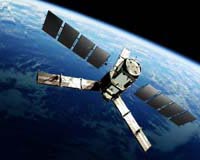 |
Science@NASA Huntsville AL (SPX) May 29, 2009 A unique signal detected by NASA's Aqua satellite is helping researchers check the health and productivity of ocean plants around the world. Fluorescent red light emitted by ocean phytoplankton and detected by Aqua reveals how efficiently the microscopic plants are turning sunlight and nutrients into food through photosynthesis. "This is the first direct measurement of the health of the phytoplankton in the ocean," says Michael Behrenfeld, a biologist at Oregon State University who specializes in marine plants. "We now have an important new tool for observing changes in phytoplankton all over the planet." The findings were published this month in the journal Biogeosciences and presented at a news briefing on May 28th. Single-celled phytoplankton fuel nearly all ocean ecosystems, serving as the most basic food source for marine animals from zooplankton to fish to shellfish. In fact, phytoplankton account for half of all photosynthetic activity on Earth. The health of these marine plants affects commercial fisheries, the amount of carbon dioxide the ocean can absorb, and how the ocean responds to climate change. Over the past two decades, scientists have employed various satellite sensors to measure the amount and distribution of the green pigment chlorophyll, an indicator of the amount of plant life in the ocean. But with the Moderate Resolution Imaging Spectroradiometer (MODIS) on NASA's Aqua satellite, scientists have now observed "red-light fluorescence" over the open ocean. "Chlorophyll gives us a picture of how much phytoplankton is present," says Scott Doney, a marine chemist from the Woods Hole Oceanographic Institution and a co-author of the paper. "Fluorescence provides insight into how well they are functioning in the ecosystem." All plants absorb energy from the sun, typically more than they can consume through photosynthesis. The extra energy is mostly released as heat, but a small fraction is re-emitted as fluorescent light in red wavelengths. MODIS is the first instrument to observe this signal on a global scale. Red-light fluorescence reveals much about the physiology of marine plants and the efficiency of photosynthesis, as different parts of the plant's energy-harnessing machinery are activated based on the amount of light and nutrients available. For example, the amount of fluorescence increases when phytoplankton are under stress from a lack of iron, a critical nutrient in seawater. The iron needed for plant growth reaches the sea surface on winds blowing dust from deserts and other arid areas, and from upwelling currents near river plumes and islands. Fluorescence data from MODIS has allowed the research team to study these dynamics. The Indian Ocean was a particular surprise, as large portions of the ocean were seen to "light up" seasonally with changes in monsoon winds. In the summer, fall, and winter - particularly summer - significant southwesterly winds stir up ocean currents and bring more nutrients up from the depths for the phytoplankton. At the same time, the amount of iron-rich dust delivered by winds is reduced. "On time-scales of weeks to months, we can use these data to track plankton responses to iron inputs from dust storms and the transport of iron-rich water from islands and continents," says Doney. "Over years to decades, we can also detect long-term trends in climate change and other human perturbations to the ocean." Climate change could mean stronger winds pick up more dust and blow it to sea, or less intense winds leaving waters dust-free. Some regions will become drier and others wetter, changing the regions where dusty soils accumulate and get swept up into the air. Phytoplankton will reflect and react to these global changes. "NASA satellites are powerful tools," says Behrenfeld. "Huge portions of the ocean remain largely unsampled, so the satellite view is critical to seeing the big picture." Share This Article With Planet Earth
Related Links Science@NASA Earth Observation News - Suppiliers, Technology and Application
 SMOS Ready To Ship To Launch Site
SMOS Ready To Ship To Launch SiteParis, France (ESA) May 29, 2009 ESA's next Earth Explorer, SMOS, has recently passed the all-important Flight Acceptance Review, signifying that all the elements that make up the mission are in place for launch later this year. The satellite can now be prepared for its journey to the Plesetsk Cosmodrome in northern Russia. The Flight Acceptance Review is a formal procedure to ensure that all the mission elements are in ... read more |
|
| The content herein, unless otherwise known to be public domain, are Copyright 1995-2009 - SpaceDaily. AFP and UPI Wire Stories are copyright Agence France-Presse and United Press International. ESA Portal Reports are copyright European Space Agency. All NASA sourced material is public domain. Additional copyrights may apply in whole or part to other bona fide parties. Advertising does not imply endorsement,agreement or approval of any opinions, statements or information provided by SpaceDaily on any Web page published or hosted by SpaceDaily. Privacy Statement |